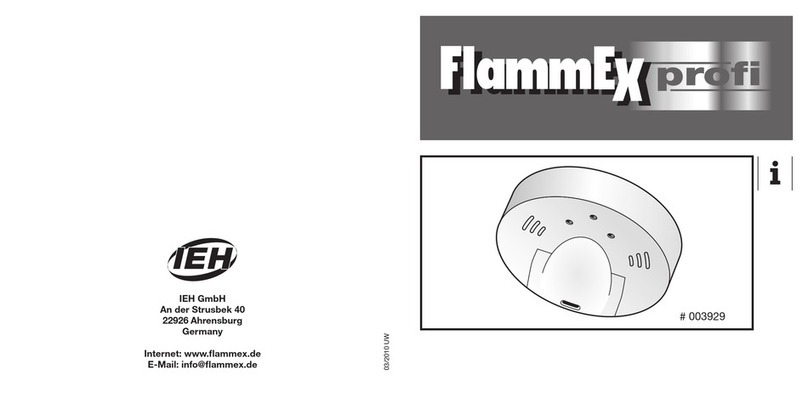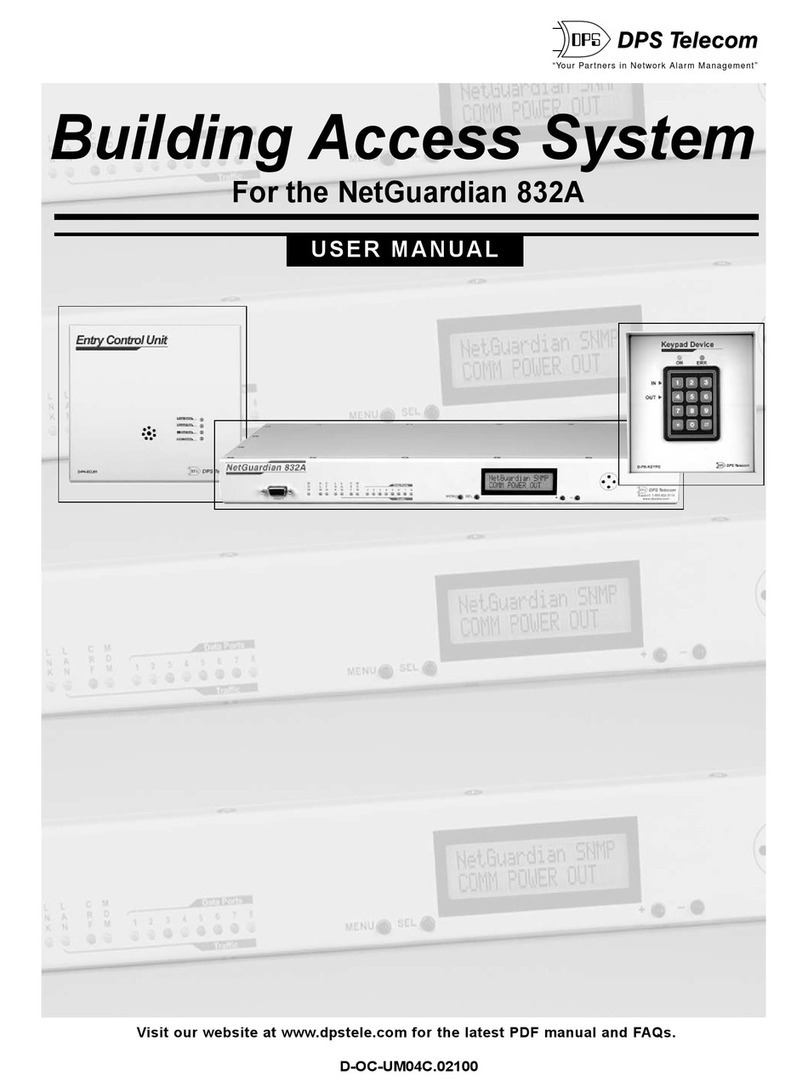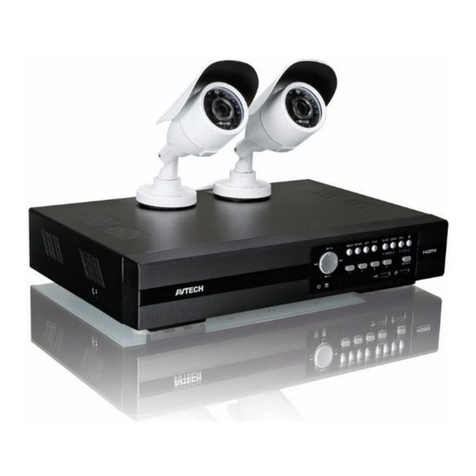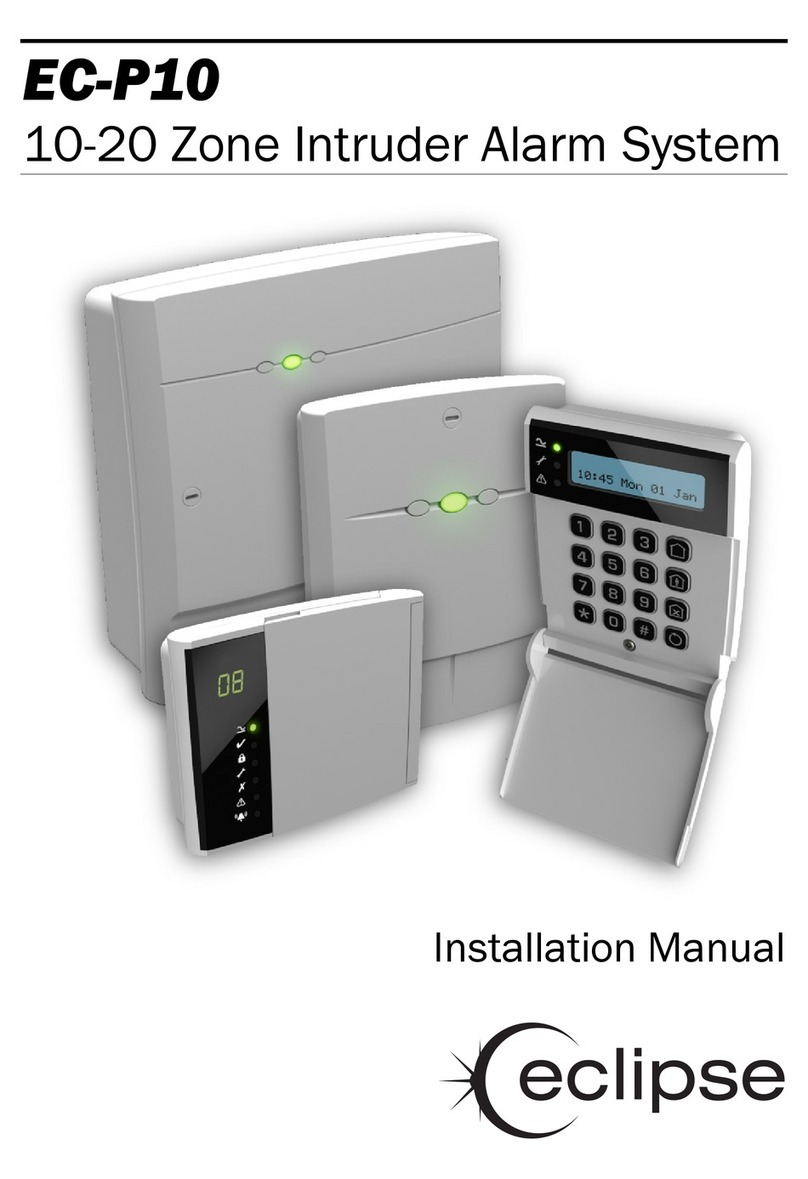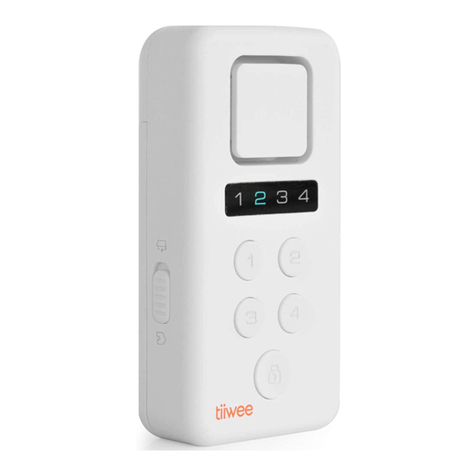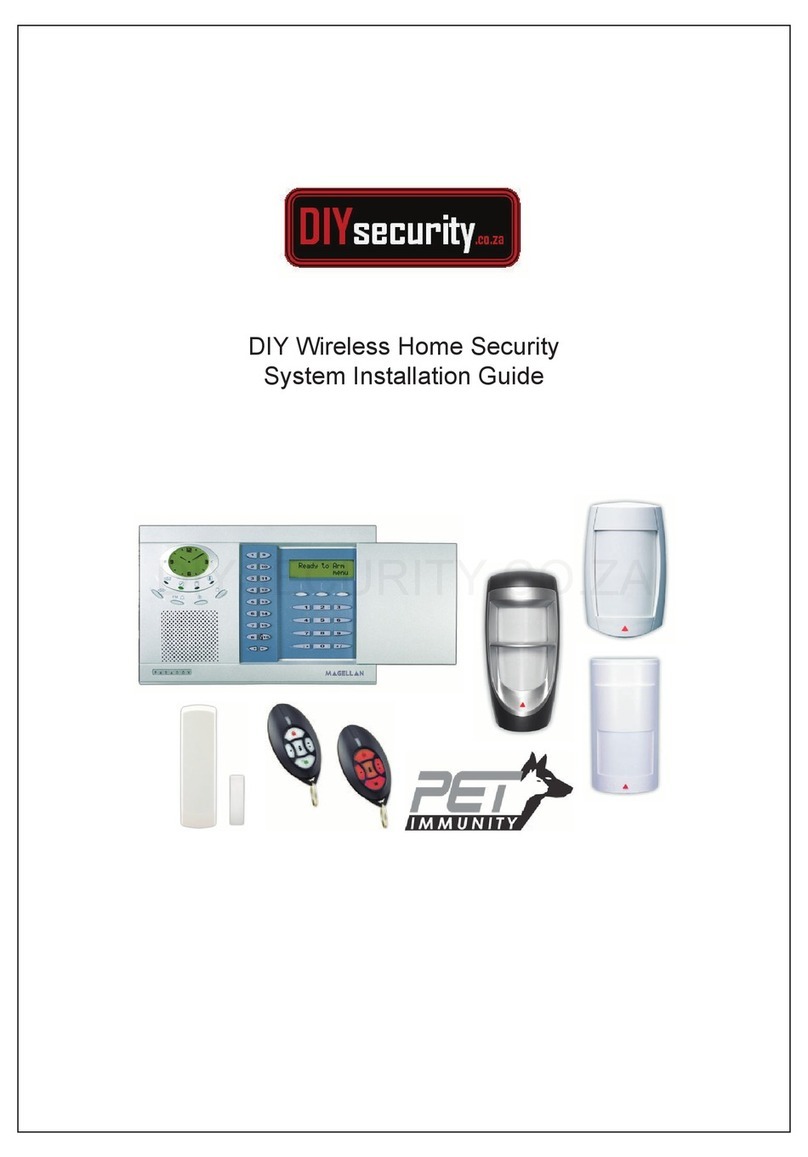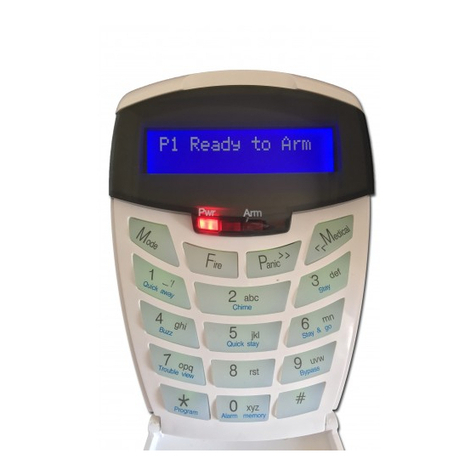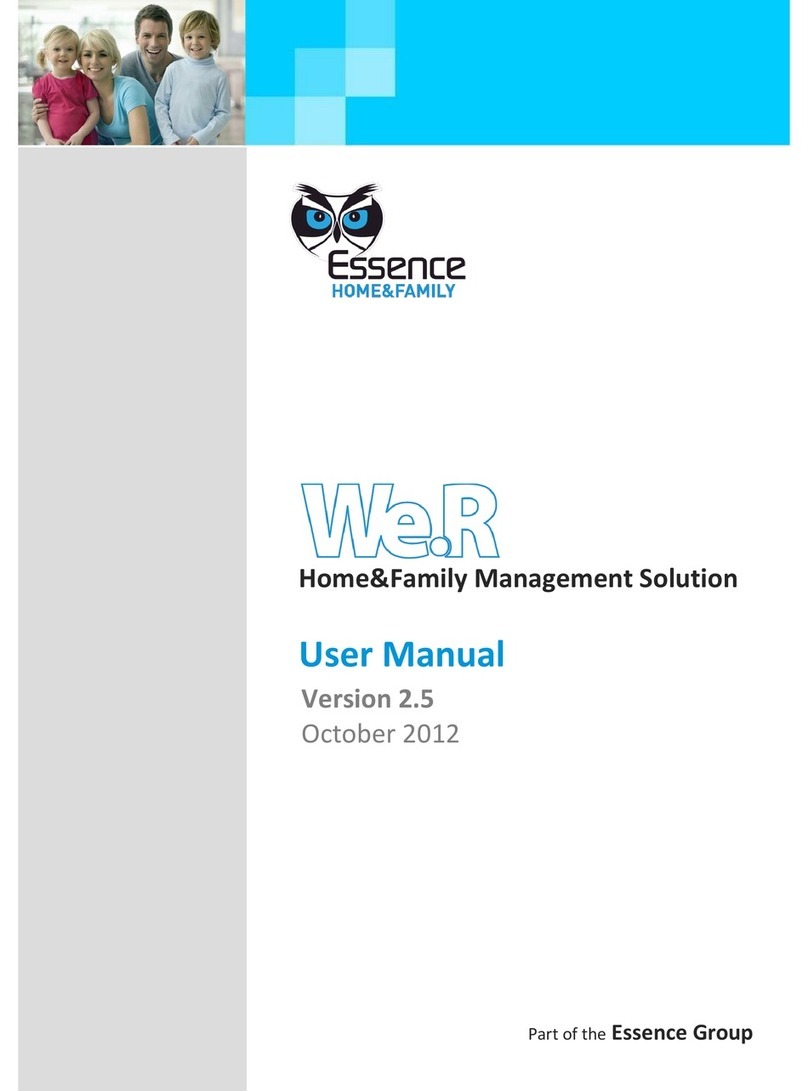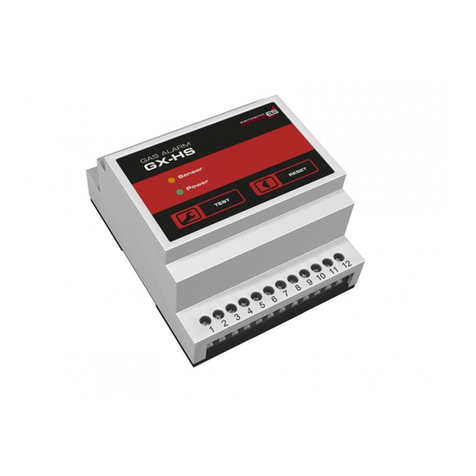ROEL Cerber c41 Assembly instructions

HOOKUP & PROGRAMMING BOOK
Cerber®C41
4 zone +1 special zone
keypad operated control panel
Doc. 10101/13.04.00 / Version 1.11

Cerber®C41
HOOKUP INSTALLATION & PROGRAMMING M ANUAL
2
Table of Contents
INTRODUCTION ...........................................................................................................4
INSTALLING AND COMMISSIONING ...........................................................................6
Commissioning ..................................................................................................................... 8
Reset to Default ................................................................................................................... 8
OPERATION .................................................................................................................9
Operation Codes .................................................................................................................. 9
Installer's Programming Code ............................................................................................... 9
Arming ................................................................................................................................ 10
Other Arming Modes .......................................................................................................... 10
Disarming ............................................................................................................................ 12
Miscellaneous .................................................................................................................... 12
Zone bypassing ................................................................................................................. 12
System State Display ......................................................................................................... 12
Alarm Memory Display ....................................................................................................... 13
Door Chime On/Off ............................................................................................................. 13
Program/Modify Access Codes ........................................................................................ 14
SYSTEM PARAMETER PROGRAMMING ................................................................. 16
Programming Sections ....................................................................................................... 17
Section [01] - Zone Definitions .......................................................................................... 17
Section [02] - KEY Zone Definition .................................................................................... 19
Section [03] - System Times .............................................................................................. 19
Section [04] - Installer's Code ............................................................................................ 20
Section [05] - Programmable Output Options For PGM1, PGM2 ...................................... 20
Section [06] - Phone Line And Communicator Options ..................................................... 21
Section [07] - First Phone Number ..................................................................................... 22
Section [08] - Second Phone Number ............................................................................... 22
Section [09] - Customer Account Code ............................................................................. 23
Section [10] - Closing Reporting Codes ............................................................................. 23
Section [11] - Opening Reporting Codes ........................................................................... 23
Section [12] - Alarm Codes ................................................................................................ 23
Section [13] - Alarm Restore Codes .................................................................................. 24
Section [14] - Trouble Codes ............................................................................................. 24
Section [15] - Message Length/Appealing Cycles Nymber .............................................. 24

Cerber®C41
HOOKUP INSTALLATION & PROGRAMMING MANUAL
3
PROGRAMMING WORKSHEETS ............................................................................. 25
[01] - Zone Definitions ....................................................................................................... 23
[02] - KEY Zone Definition ................................................................................................. 23
[03] - System Times ........................................................................................................... 24
[04] - Installer's Code .........................................................................................................24
[05] - Programmable Output Options for PGM1, PGM2 ..................................................... 24
[06] - Phone Line and Communicator Options ................................................................... 24
[07] - First Phone Number .................................................................................................. 25
[08] - Second Phone Number ............................................................................................. 25
[09] - Customer Account Code .......................................................................................... 25
[10] - Closing Reporting Codes .......................................................................................... 25
[11] - Opening Reporting Codes ........................................................................................ 25
[12] - Alarm Codes ............................................................................................................. 27
[13] - Alarm Restore Codes ............................................................................................... 27
[14] - Trouble Codes .......................................................................................................... 27
[15] - Message Length Programming/Appealing Cycles Number ..................................... 27
Warning Limitations of this Alarm System ......................................................................... 27

Cerber®C41
HOOKUP INSTALLATION & PROGRAMMING M ANUAL
4
INTRODUCTION
Cerber C41 is a keypad operated burglary system, with built-in monitoring
facilities, alarm memory and 4 access codes.
The system facilities are keypad programmable. The central unit is RISC
microprocessor designed. The electric scheme includes an EEPROM
memory. Thus, the programmed parameters are retained even after all power
was removed from the control panel.
FEATURES:
4 End-of-Line zones programmed as Entry/Exit, Instant, Follower or 24
hour.
1 "Keyswitch"/Tamper zone.
Keypad programming.
4 user codes: 1 Master code and 3 programmable access codes .
Optional Ambush code (code 4),
Quick arming, Stay arming, Instant stay arming
Bypass.
User programmable Chime function.
Programmable Bell cut-off time: Steady, Pulse or Silent.
Programmable Entry delay, Exit delay
Optional Keyswitch arming/disarming.
9 options for 2 programmable outputs which are: Latch on alarm, Arm-
ing/Disarming, Entry delay, Exit delay, Trouble, Steady siren, Pulsing
siren, Silent alarm, Panic.
128 event LOG transmitted to Central station on telephone line
The first 9 alarm events displayed on keypad.
Digital communicator with programmed transmission 10PPS speed in
4x2 parity format, handshake 1400Hz / 2300Hz or DTMF Ademco 4x2
Express.
Optional message voice module

Cerber®C41
HOOKUP INSTALLATION & PROGRAMMING MANUAL
5
2 programmable central station phone numbers.
Monitoring system and battery state, and AC power
EEPROM memory retains all programming, even after all power is removed
from the control panel
Up to 4 keypads, 4 wire linked
Keypad tamper using microswitch
Individual state LEDs for each zone, indicating the alarm state
System state LEDs which are: READY, SYSTEM, ARMED
TECHNICAL SPECIFICATIONS:
Power
12V/4Ah battery
50mA stand-by current
500mA maxim power output on AUX
Inputs
4 fully programmable 2K2 EOL zones.
1 Keyswitch/tamper 2K2 EOL zone.
Outputs
2 "open-collector" outputs with negative trigger, max. 100mA
1 "open-collector" siren output with positive trigger, max. 1A

Cerber®C41
HOOKUP INSTALLATION & PROGRAMMING M ANUAL
6
INSTALLING AND COMMISSIONING
PANEL MOUNTING
The location must be close to a telephone line and a ground 220VAC source.
Remove the printed circuit board and mount the cabinet onto the wall using 4
screws. Mount the PCB into the cabinet. Pull all cables into the cabinet and
prepare them for connection.
KEYPAD MOUNTING
The keypad should be located close to the designed Entry/Exit door and
mounted at a convenient height for all users.
Disassemble the keypad and mount the backplate on the wall. Pull the
keypad wiring inside the keypad and prepare it for connection.
WIRING
NOTE: Complete all wiring before applying the control panel to
battery or AC power.
Wiring should be done according to the next diagram.

Cerber®C41
HOOKUP INSTALLATION & PROGRAMMING MANUAL
7
RED
BATTERY
12V/4Ah
BLACK
KEYPAD
GRN
REZISTOR
EOL 2K2
REZISTOR
EOL 2K2
REZISTOR
EOL 2K2
MOMENTARY
KEYSWITCH
NC
YEL
PHONE
LINE
PHONE
SET
AUX
1,6A
SIREN
1,6A
SIREN
OUTPUT
MAX 1A
OBSERVE
POLARI TY
+
-
GND
+12VDC
AUX
FUSE
BELL
FUSE
F2 F1
Room for
MPV4+
module
CONNECTING TERMINALS
The following PCB connectors are located on the control panel:
AUX - , AUX +
Connectors for auxiliary power supply.
These terminals supply power for keypads, PIR detectors and other active
devices inside the system.
The maximum load on these terminals cannot exceed 500mA. Observe
polarity!

Cerber®C41
HOOKUP INSTALLATION & PROGRAMMING M ANUAL
8
YEL, GRN
Keypad communication.
PGM 1, PGM 2
Programmable "open collector" outputs with negative trigger. The maximum
load on these terminals cannot exceed 100mA.
BELL +, BELL -
Siren output. "BELL+" is a positive trigger output.
The maximum load on these terminals cannot exceed 1A. Observe polar-
ity!
KEY
Terminals for Keyswitch/Tamper zone (see mounting diagram on page 5).
If not used, the terminals will be closed with a 2K2 EOL resistor.
Z1, COM, Z2, Z3, COM, Z4
Terminals for fully programmable zones (see mounting diagram on page 5).
If not used, the terminals will be closed with a 2K2 EOL resistor.
SET
Phone set.
LINE
Phone line.
COMMISSIONING
When finishing connections, first reset the system following the procedure
described bellow.
Reset to Default
1. Disconnect power, both batteries and AC power.
2. Connect jumper JP10 on PCB.
3. Power the panel and wait for 2 seconds..
4. If the system was reset to default, zone LEDs will blink successively, and
the green "READY" LED will turn on.
5. Disconnect power, both batteries and AC power.
6. Take jumper JP10 off PCB.
7. Power the panel. From now on, the system parameters are set to default
and the system is disarmed.

Cerber®C41
HOOKUP INSTALLATION & PROGRAMMING MANUAL
9
OPERATION
Zone LEDs
SYSTEM LED
READY LED
ARMED LED
System operation is done using the keypad and LEDs' indications. There are
4 zone LEDs and 3 state LEDs (READY, SYSTEM, ARMED) on the keypad.
OPERATION CODES
There are 4 programmable operating codes in the system. Only the Master
code is programmed by default. The default value for the Master code is
"1234". Using the Master code, one can operate the system and program the
other user codes.
If programmed, the fourth code becomes the "ambush code". When
disarming, using this particular code, the panel will transmit a special code
meaning that the system was disarmed under threat.
Modifying codes, including Master code, is done by [*][7][Master Code]
command.
INSTALLER'SPROGRAMMING CODE
The default Installer's Programming Code is 0269.
Using this code and the [*][8][Installer's code] command, the installer can
perform programming functions.
The installer should change the code after installing the system!

Cerber®C41
HOOKUP INSTALLATION & PROGRAMMING M ANUAL
10
ARMING
Before arming the system, make sure that all protected doors and windows
are closed.
If the System LED is lit, check the following:
- the alarm memory ([*][5] command). If there are alarms in the memory, they
will be cleared when arming the system.
- bypassed zones ([*][3] [Access code] command). Make sure that all zones
displayed as being bypassed are intentionally bypassed.
- system trouble ([*][4] command). If there is trouble with the battery or the
AC power, fix them before arming.
If "READY" LED is not lit, then one or more zones are opened. One cannot
arm the system unless "Ready" LED is lit.
To arm the system, introduce a 4 digit access code. Whenever a key is
pressed, the keypad buzzer will emit a short beep.
After pressing the access code, the "Armed" LED will turn on and the keypad
buzzer will emit 6 beeps.
If the access code is not correct, the keypad buzzer will sound a long beep.
Press the [#] key, and then press the access code again.
After pressing the access code and the "Armed" LED was lit, exit the
protected area through the Entry/Exit zone before the Exit time was over.
After the Exit time was over, all LEDs will be off except the "Armed" LED.
The default Exit time is 120 seconds (see section [03]).
OTHER ARMING MODES
QUICK-ARM
[*] [0]
This function will be used by someone who doesn't own an access code.
Arming will be done by pressing the sequence [*][0]. Next, the user should
leave the protected area before Exit time was over. After the Exit time was
over, the whole system will arm and the "Armed" LED will stay lit.
INSTANT STAY ARMING
[*] [1] [ACCESS CODE]
Thisarmingmodeis
used for perimetral protection. Thus, the user can stay inside the protected
area (i.e.: arming the panel at night while staying home).

Cerber®C41
HOOKUP INSTALLATION & PROGRAMMING MANUAL
11
After pressing the access code, the system automatically isolates the
"Follower" zones. That is why the yellow "System" LED will be lit. After
the Exit time was over, "delayed" zones will become "Instant" and they
will trigger an alarm the very moment they are opened.
The red "Armed" LED will blink, indicating that the delayed zones are
"instant" now.
STAY ARMING
[*] [2] [ACCESS CODE]
This arming mode is also used for perimetral protection. This time the user
also stays inside the protected area, but is allowed access through the
Entry/Exit zones.
After pressing the access code, the system automatically isolates the
"Follower" zones. Thus, the yellow "System" LED will be lit. After the
Exit time was over, the whole system will arm and the "Armed" LED will stay
lit.
Note:
Entry/exit and follower zones can be programmed for forced arming. So, when
arming, these zones will be bypassed untill they are closed after exit delay
was over.
Forced arming option is necessary in case of leaving the system using a
door which has a magnetic contact mounted on an entry/exit zone, the door
being watched by a PIR detector mounted on a follower zone. If exit delay is
shorter than the stabilization time of PIR detector, then both zones will be
programmed as being forced armed in order to be bypased when arming the
system. Zone bypassying cancellation will occur when the zones will be
closed (meaning when closing the door at the moment of leaving the
protected area)
DISARMING
One can only enter the protected area through an Entry/Exit zone. While
opening Entry/Exit zone, Entry time will begin counting.
Keypad buzzer will sound a continuous beep during the Entry time, indicating
that the system should be disarmed.

Cerber®C41
HOOKUP INSTALLATION & PROGRAMMING M ANUAL
12
Press one of the access codes. If wrong, press [#] key and repress the code
again.The "Armed" LED will be off and so will the buzzer.
If the system is not disarmed during the Entry time, the panel will alarm. In
order to modify the Entry time, see PROGRAMMING chapter, section [03].
MISCELLANEOUS
ZONE BYPASSING
[*] [3] [ACCESS CODE]
The initiating devices from a bypassed zone will not be considered by the
panel. Zone bypassing is used when access is needed in that particular zone
even if the system is armed. Zone bypassing is also used when some
initiating devices or wires are damaged and restoring is not immediately
possible .
Arming can be done having one or more zones bypassed even if they are
opened.
While the system is disarmed, press [*] [3] [Access code] to display the
bypassed zones. The "System" LED will blink and the corresponding zone
LEDs will be lit.
To bypass a zone, press the corresponding digit while the corresponding LED
will turn ON. To un-bypass a zone, press the corresponding digit while the
corresponding LED will turn OFF.
Exit bypassing mode by pressing [#].
NOTE: When disarming the system, the bypassed zones will be cleared.
SYSTEM STATE DISPLAY
[*] [4]
The alarm system monitors some trouble conditions. If one of these
conditions occurs, the "System" LED will turn ON.
To display these conditions, press [*] [4]. The conditions will be displayed on
zone LEDs as follows:
Zone 1 LED - Low Battery: if the battery is disconnected or LOW, this LED
is lit. The LED is also lit if the battery circuit fuse is burnt. The LED will turn
OFF within 8 seconds after restoring the battery trouble.
Zone 2 LED - AC Power OFF: if AC power is OFF or the transformer is
burnt, this LED is lit. The LED is also lit if AC power circuit fuse is burnt. The
LED will turn OFF instantly after restoring AC power trouble.

Cerber®C41
HOOKUP INSTALLATION & PROGRAMMING MANUAL
13
Zone 3 LED - Unsuccessful Communication Attempt: If the digital commu-
nicator cannot communicate with the central station after 8 attempts, a
trouble is generated and this LED will be lit. If a later attempt to communicate
is successful, the trouble is cleared and the LED will turn OFF. The trouble
will also clear when exiting this display trouble condition mode.
To exit this mode press [#] key.
ALARM MEMORY DISPLAY
[*] [5]
The alarms produced during the last arming are memorized. To display the
alarmed zones press [*] [5].
"System" LED will blink and so will the LEDs of the last alarmed zones. One
can press 1 to 9 keys in order to visualize the first 9 alarmed zones during
the last arming of the panel. Pressing the key [1] one of zone LEDs will turn
on showing the first zone alarmed, while pressing the key [9] one of zones
LEDs will turn on showing the most recently alarmed zones.
Pressing the key [0] one can see all the alarmed zones simultaneously. All
the corresponding zone LEDs will blink.
To exit this display mode press [#] key.
The alarm memory will clear while arming the panel again .
DOOR CHIME ON/OFF
[*] [6]
The Door Chime feature causes the keypad buzzer to sound 6 short beeps
whenever a delayed zone is activated. The feature is useful if the Entry/Exit
doors are out of view and the user desires an indication of when the door
zones are opened.
The Door Chime feature works only with the system disarmed.
The feature may only be turned on/off also while the system is disarmed. To
turn the feature on/off enter [*] [6] command. If the feature is being turned
ON, the keypad buzzer will beep 3 times. If the feature is being turned OFF,
the keypad buzzer will sound only one long beep.

Cerber®C41
HOOKUP INSTALLATION & PROGRAMMING M ANUAL
14
PROGRAM/MODIFY ACCESS CODES
[*] [7] [MASTER CODE]
The [*] [7] [Master Code] command allows the user to program the Master
Code and 3 additional Access Codes.
Enter [*] [7] [Master Code].
The LEDs Ready, Armed and System will blink.
The lit zone LEDs will indicate which codes have already been programmed.
By default, only zone 1 LED will be lit indicating that only Master Code is
programmed (Master Code is code number 1).
From this moment on, the codes are to be modified as follows:
Changing or Adding a Code
To change/add Access Codes 1 to 4 enter the number of the code to be
changed/added.
The corresponding zone LED will begin to blink, and the keypad buzzer will
sound 3 beeps. Enter a new 4 digit Access Code. Do not press [*] or [#]
when entering the code.
After the code was entered, the keypad buzzer will sound 6 beeps and the
corresponding zone LED will stay lit.
If an existing code is being changed, the new code will replace the old one.
Thus, all the desired codes will be changed.
Erasing a Code
To erase a code enter the number of the code to be erased.
The corresponding zone LED will blink, and the keypad buzzer will sound 3
beeps. Enter [****] to erase the Access Code.
NOTE: Do not erase Master Code! If, by mistake, the Mater Code is
erased, reset system programming to factory default settings. (see Commis-
sioning).
In this programming mode, the LEDs "Ready", "System" and "Armed" will
blink continuously and zone LEDs will display as follows:
ZONE LED ACCESS CODE IS:
OFF not programmed
ON steady programmed
Blinking presently being programmed
After all the desired changes were made, exit the code programming by
pressing [#] key.

Cerber®C41
HOOKUP INSTALLATION & PROGRAMMING MANUAL
15
DIALING STOP
[*] [9] [MASTER CODE]
This command is necessary only when optional voice modul e MPV 4+ is
used.
[*] [9] [Master Code] command allows the user to stop phone dialing. This
command is only accepted in disarmed mode of the system.
So, if while armed, the alarm is triggered and the communication starts, in
order to stop the dialing, one should first disarm the system using a valid
code. Then, to stop the dialing one should press the sequence [*] [9] [Master
Code].
VOICE PROCCESSOR MODULE MPV 4+
Voice processor module is used just in case of total or temporary
renouncement of one central station services.
INSTALLATION
The module will be mounted onto the matching connector situated up-right on
the main board.
VOICE MESSAGE RECORDING
In order to record a voice message, proceed as follows:
1. Open the control panel lid;
2. Hold INREG. button pressed (see wiring diagram);
3. After the red LED was lit, keep holding INREG. button pressed, speak
clearly in the microphone, paying attention to the length of the message
which should not exceed 30s.
Note:
If the message is longer than 30s, the LED will turn off and recording will
automatically stop. In this case, record a shorter message again.
4. In order to stop recording, release INREG. button.
In order to check the local recorded message proceed as follows:
1. Connect a temporary 8Ohm mini-speaker to DIFUZOR (speaker)
terminalsof module MPV 4+.
2. Press REDARE button shortly and listen to the mesage;
3. Disconnect the speaker;
4. Open the control panel lid.

Cerber®C41
HOOKUP INSTALLATION & PROGRAMMING M ANUAL
16
SYSTEM PARAMETER PROGRAMMING
ENTERING THE PROGRAMMING MODE OF SYSTEM PARAMETERS
[*] [8] [INSTALLER'SCODE]
Entering the programming mode of system parameters is made by
[*][8][Installer's Code] command, only in disarmed mode. The programming
options of the system are explained bellow.
The default Installer's Code is [0269] and it is strongly recommended to be
changed after installing the alarm system.
After pressing [*][8][Installer's Code], the keypad buzzer will sound 3 beeps,
and the LEDs will display as follows:
LED STATE LED
Ready OFF
System Blinking
Armed ON
Zone LEDs OFF
Now you have just entered the system parameter programming mode.
To leave the programming mode press [#] key.
System parameters are grouped in sections counted from 01 to 14. To enter
each section press the 2 corresponding digits.
After entering the 2 digits, the keypad buzzer will sound 3 beeps and the
LEDs will display as follows:
LED STATE LED
Ready ON
System Blinking
Armed ON
Zone LEDs OFF
Now you are inside the system parameter programming mode.
To leave the section press [#] key.
Certain programming entries may require entry of data in HEX. To enter data
in HEX format, first press the [*] key followed by a number according to the
data in the table bellow:

Cerber®C41
HOOKUP INSTALLATION & PROGRAMMING MANUAL
17
HEX digit
A Enter [*][0]
B Enter [*][1]
C Enter [*][2]
D Enter [*][3]
E Enter [*][4]
F Enter [*][5]
Note that after pressing the [*] key, Ready LED will blink and after entering
the decimal digit, the LED will stay lit.
PROGRAMMING SECTIONS
SECTION [01] - ZONE DEFINITIONS
Enter 4 groups of 2 digits each to determine the 4 zone characteristics.
First digit from each group represents a zone type and could be:
[0] ENTRY/EXIT
An Entry/Exit zone is usually used for Entry/Exit doors. The Exit Delay
starts when the system is armed. The zone may be opened and closed
during the delay without causing an alarm.
When the Exit Delay expires, zone opening will start the Entry Delay. During
the Entry Delay, the keypad buzzer will sound continuously to indicate that
the system should be disarmed. If the system is disarmed before the Entry
Delay expires, no alarm will be generated.
Entry and Exit Delay times may be independently programmed for 1 to 255
seconds in section [03]. The default settings are 120 seconds for the Exit
Delay and 30 seconds for the Entry Delay.
This zone type can be forced arming programmed.
[1] INSTANT
Instant zones are normally used for door and window contacts. Instant zones
have standard Exit Delay, but will generate an instant alarm when opened
after Exit Delay expired.
The Exit Delay is the same for Entry/Exit zones and is 120 seconds by
default.

Cerber®C41
HOOKUP INSTALLATION & PROGRAMMING M ANUAL
18
[2] FOLLOWER
The Follower zones are used with interior motion detectors and follow the
standard Exit Delay. If one enters the system through a Entry/Exit zone, then
the Follower zone will have the standard Entry Delay. If one enters the
system through a Follower zone without coming through an Entry/Exit zone,
an alarm will be generated.
This zone type cacn be forced arming programmed.
[3] 24-HOUR
The 24-hour zones are permanently active. If such a zone is tripped, an alarm
will be generated even if the system is disarmed.
The second digit indicates the alarm type. There are 6 alarm types:
[0] CONTINUOUS
This kind of alarm sends an alarm message and enables the siren.
[1] PULSING
This kind of alarm sends an alarm message and enables the pulse siren.
[2] SILENT
This kind of alarm sends an alarm message only on phone lines and does
not enable the siren.
[3] CONTINUOUS ALARM AND FORCED ARMING
The zone sends an alarm message on phone lines and enables the siren.
The system can arm itself even if this zone is open when arming.
[4] PULSING ALARMING AND FORCED ARMING
The zone sends an alarm message on phone lines and enables the pulse
siren. The system can arm itself even if this zone is open when arming.
[5] SILENT ALARMING AND FORCED ARMING
The zone sends an alarm message on phone lines and does not enable the
pulse siren. The system can arm itself even if this zone is open when arming.
NOTE!
Forced arming alarming type is available only for Entry/Exit and Follower
zones.
EXAMPLE: The zones should be programmed as follows:
- zone 1 - Entry/Exit with continuous alarm
- zone 2 - Follower with continuous alarm

Cerber®C41
HOOKUP INSTALLATION & PROGRAMMING MANUAL
19
- zone 3 - Instant with continuous alarm
- zone 4 - 24-hour with pulsing alarm
After entering the section by pressing [0][1], enter the sequence:
[0] [0] [2] [0] [1] [0] [3] [1]
After every 2 digits, the keypad buzzer will sound 3 beeps. After the last 2
digits, the keypad buzzer will sound 6 beeps and will exit section [01],
waiting for a new command.
SECTION [02] - KEY ZONE DEFINITION
Enter 2 digits to determine KEY zone characteristics.
First digit represents KEY zone type and could be:
[3] PANIC OR TAMPER
The Panic zone is permanently active and it will generate alarm even if the
system is disarmed.
[4] KEY ARMING / DISARMING
The system could be armed/disarmed using a Normally Closed keyswitch.
The keyswitch used should be a kind of a momentary keyswitch. If the
system is disarmed, then zone opening will arm the system. If the system is
armed, then zone opening will disarm the system. If the siren is activated,
then zone opening will stop the siren.
The second digit indicates the alarm type produced by the KEY zone.
The same kind of alarm will produce the simultaneous pressing of [*]
and [#] keys. The programming is the same as in section [01].
SECTION [03] - SYSTEM TIMES
Enter 3 groups of 3 digits each, to establish respectively the three system
times:
ENTRY DELAY
(001 to 255 seconds). The Entry Delay determines the amount of time
permitted between the activation of an Entry/Exit zone and the disarming of
the system. If the system is not disarmed during this delay, an alarm will be
generated. The default Entry Delay is 30 seconds.
EXIT DELAY
(001 to 255 seconds). The Exit Delay determines the amount of time permit-
ted between entering an Access Code to arm the system and the activation
of an Entry/Exit zone to exit the protected area. The default Exit Delay is 120
seconds.

Cerber®C41
HOOKUP INSTALLATION & PROGRAMMING M ANUAL
20
BELL CUT-OFF
(001 to 255 minutes). This sequence of time determines how long the siren
will sound when an alarm is generated. When an alarm is initiated, the siren
will sound for this length of time, or until the alarm is silenced by entering an
Access Code. The default setting is 3 minutes.
EXAMPLE: The sequences of time should be programmed as follows:
- Entry Delay 10 seconds
- Exit Delay 60 seconds
- Bell Cut-Off 3 minutes
After entering the section by pressing [0][3], enter the sequence:
[0] [1] [0] [0] [6] [0] [0] [0] [3]
After every 3 digits, the keypad buzzer will sound 3 beeps. After the last 3
digits, the keypad buzzer will sound 6 beeps and will exit section [03],
waiting for a new command.
SECTION [04] INSTALLER'SCODE
The default value for the Installer's Code is [0269]. It is strongly recom-
mended to change this code when the alarm system installation is over.
Keep the new code in a safe place.
Enter 4 digits [X] [X] [X] [X]. After that, the keypad buzzer will sound 6 beeps
and will exit section [04], waiting for a new command.
SECTION [05] PROGRAMMABLE OUTPUT OPTIONS FOR PGM1, PGM2
Enter 2 digits.
First digit refers to PGM1 and the second digit refers to PGM2 and they
stand for:
[0] LATCH ON ALARM
the output goes to ground in case of alarm and is shut OFF when disarming
[1] FOLLOW SYSTEM STATE
the output goes to ground when arming and is shut OFF when disarming
[2] ENTRY DELAY
the output goes to ground during the Entry Delay
[3] EXIT DELAY
the output goes to ground during the Exit Delay
Other ROEL Security System manuals

